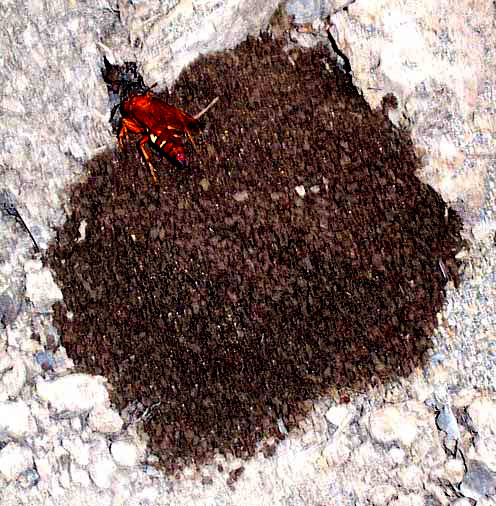Excerpts from Jim Conrad's
Naturalist Newsletter
from the May 26, 2007 Newsletter issued from Sierra Gorda Biosphere Reserve, QUERÉTARO, MÉXICO
CICADA KILLERS
Near that same area the reservoir's main source stream cuts a narrow channel through a mudflat that most of the year is submerged. The channel's banks are steep and composed of loose, sandy alluvium. Here and there along the banks I found numerous recently excavated holes, or tunnels, about big enough to stick my little finger into. As I stood there trying to decide who was doing the digging, a large, stocky, amber-colored wasp landed at a tunnel's mouth, entered, and immediately began kicking dirt from the hole. Before long I'd seen several such wasps coming and going from holes, and some kicked out dirt.
Then a wasp landed carrying beneath her a cicada larger than herself, and in less than a second both wasp and cicada disappeared into a tunnel. During maybe five minutes I saw four such wasps carrying cicadas into tunnels, each cicada being carried belly-up, the victim's silvery-white ventral surface showing very conspicuously.
My digital camera needs to whirr and blink a bit before a picture is snapped so I never was fast enough to capture an image of a cicada being carried into a tunnel, but I did indeed photograph a wasp at a tunnel's entrance, and you can see that picture below:

The wasps were SPHECIUS CONVALLIS, sometimes known as Pacific Cicada Killers, even though here we're closer to the Gulf Coast than the Pacific. The cicadas being carried into the tunnels had been stunned by the wasps' stings, but not killed. The female cicada killer carries a paralyzed cicada into her burrow, deposits it in a nest cell, lays an egg on the cicada and seals the cell. When a grub hatches from the egg it eats the cicada, which meanwhile has not rotted because it has remained paralyzed but alive, and then...
Sphecius convallis's entire lifecycle isn't known. Eastern North America is home to a cicada-killer species similar to ours, and it's been studied, so we know that after that species' grub eats its cicada it overwinters underground in a hard cocoon. It pupates the next spring, metamorphoses from the puapa in July or August, digs its way to the surface and lives aboveground for up to six weeks. Its life aboveground as an adult, which accounts for less than 10% of its total life cycle, coincides with cicada emergence.
If our species has a similar lifecycle, then in a few weeks when the rainy season raises the reservoir's water level, all the nests I saw this week will be submerged for many weeks. Are the nests doomed, or are they sealed against the water? It's very unlikely that adults will emerge before the nests are flooded, for cicada killer lifecycles are coordinated with cicada emergences, and our cicada population already seems to be declining. I'm in contact with Dr. Chuck Holliday at Lafayette College in Pennsylvania, who has seen this species nesting in other sites prone to flooding, and who is excited about learning more about our population.
One thing certain about our cicada killers is that right now they have plenty of cicadas at hand. Cicadas have been calling here for about a month. At dusk, during the half hour of dim light preceding complete darkness, cicadas are so loud around my casita that one must stand near and speak loudly to be understood. Sometimes the sound tilts from "amazing" to "painful."
However, this week I've begun seeing lots of cicadas lying on the ground with their white bellies skyward, usually with a line of ants trailing from them, the ants hollowing out the cicada exoskeletons. I suspect that our cicada peak has passed, and as the rainy season approaches dusk will start growing a little quieter.